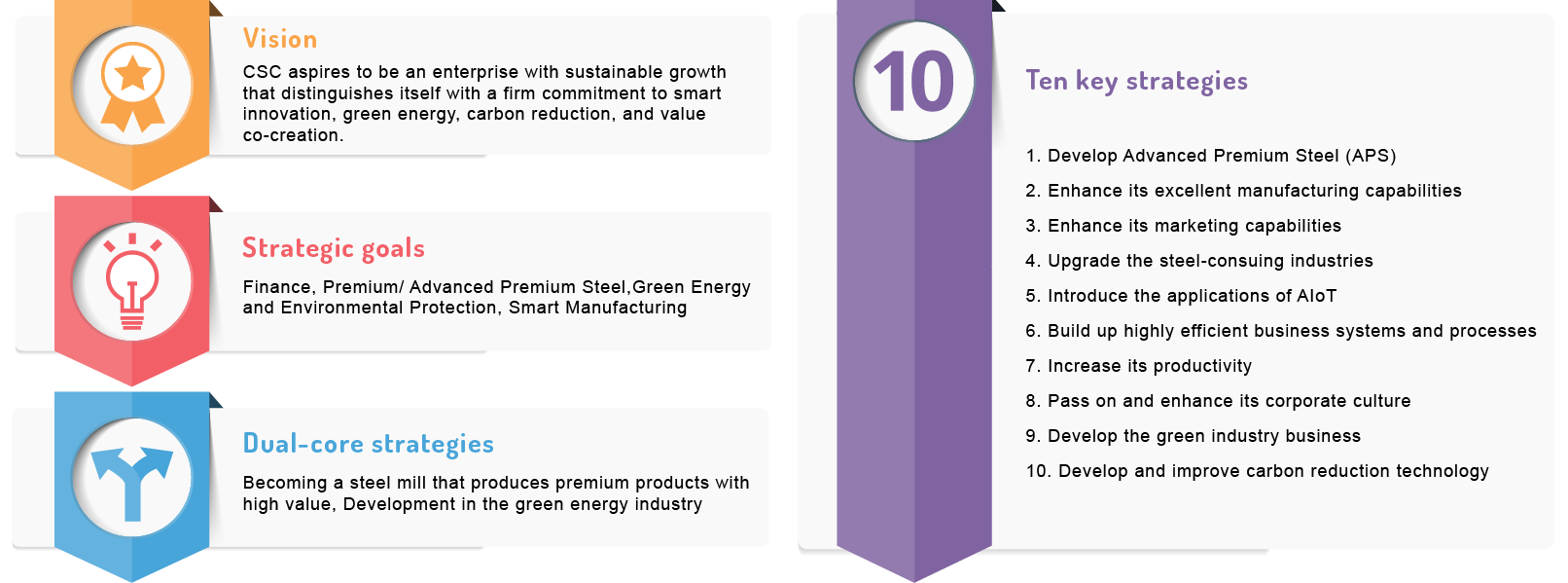Operation and Development Strategies
In 2022, CSC compiled its first 10-year (2023~2032) operation and development strategies. With the establishment of a table of future events, CSC can examine major challenges that it will face in the future and formulate strategies and specific measures to respond to them in the next decade. It has reported the results of its implementation and tracked their statuses to the Corporate Governance and Sustainability Committee semiannually and to the Board of Directors at the end of the year since 2023.
With the vision of aspiring to be an enterprise with sustainable growth that distinguishes itself with a firm commitment to smart innovation, green energy, carbon reduction, and value co-creation, CSC has formulated its operation and development strategies. Guided by this new vision, CSC has continued to enhance and optimize its production processes, product portfolios, operational models, green energy and carbon reduction, investment deployment, and corporate governance. The focus has shifted from mere quantitative changes to qualitative changes; that is, instead of pursuing more production capacity of steel, the emphasis is now on the creation of greater value in steel.
CSC's 10-year operation and development strategies encompass four main strategic goals, including finance, production of premium/advanced premium steel, green energy and environmental protection, and smart manufacturing. With the dual-core strategies for its operational development, i.e., "becoming a steel mill that produces premium products with high value" and "development in the green energy industry," 10 key strategies and various action plans have been developed. The main focuses are listed as follows:
-
Becoming a steel mill that produces premium products with high value
CSC will continuously promote the development of Advanced Premium Steel (APS) products, actively expand the sales of high performance structural steels, and promote high-recyclability steel for computer casings and self-adhesive coated electromagnetic steel sheet applications. CSC will continue to cultivate potential APS products and improve manufacturing processes to enhance the gross margin of quasi-APS products.
01 -
Development in the green energy industry
Focusing on solar photovoltaic and offshore wind power as key projects:
02
Solar photovoltaic:
Continuously expand rooftop solar photovoltaic projects, with the overall target installation capacity exceeding 120MW. CSC plans to gradually enter into the application field of energy storage systems, power auxiliary services, and other green energy-related projects.
Offshore wind power:
The projected annual electricity generation of The Zhong Neng offshore wind project is approximately 1.1 billion kilowatt-hours over the coming years, with a carbon reduction potential of 550,000 tons per year. -
Digital transformation
Promote data-driven infrastructure, establish an AI foundation model tailored for the steel industry, and integrate processes+AI to enhance productivity, serving as the foundation for supporting low-carbon transformation and supply chain transformation.
03 -
Low-carbon transformation
Continuously advance energy efficiency improvement initiatives, plan optimal production volumes, and employ measures such as incorporating low-carbon iron sources into blast furnaces, increasing scrap steel utilization in converters, promoting co-production of steel and petrochemicals, and injecting hydrogen-rich gases into blast furnaces to achieve short- and medium-term carbon reduction targets.
04 -
Supply chain transformation
Increase the proportion of direct orders from domestic customers, accelerate the development of low-carbon products, enhance sales channel loyalty, and actively implement a dual-value (value and price) enhancement strategy in collaboration with customers through EVI (Early Vendor Involvement) technical marketing. This approach aims to create value for customers and generate pricing power for CSC.
05

